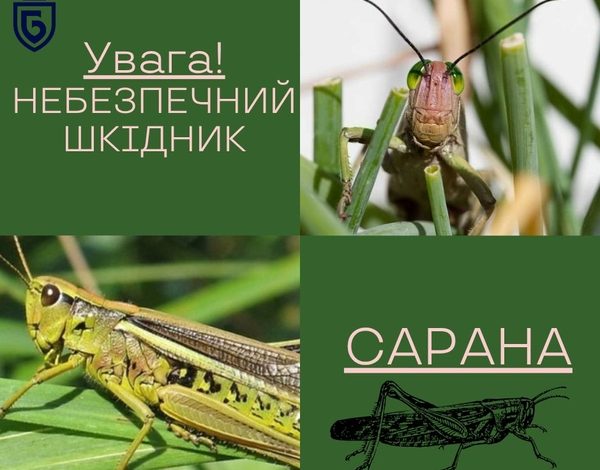
In Ukraine, particularly in the Zaporizhzhia and Kharkiv regions, there is a mass breeding of a very dangerous polyphagous pest – locusts, which causes damage to agricultural crops.
The length of this insect’s body ranges from 1 to 10 cm, depending on the species, usually greenish or brown in color, and it may have spots. It has two pairs of wings, the front being stiff, the rear larger and used for flying. It has large eyes and short antennae (unlike grasshoppers, which have long antennae, sometimes longer than their body size).
From time to time, locusts can form huge swarms and migrate over long distances, sometimes forming swarms up to 100 km long and weighing 15,000 tons. When locusts gather in swarms, they become aggressive and change their body color to red. The most potentially dangerous of Ukraine’s locusts are herd species – the Italian locust, migratory (Asian) locust, and Egyptian locust.
The harmfulness of locusts is due to their extremely high feeding intensity, the ability to mass-reproduce, and flight over long distances by some species. During mass migration, they can destroy the entire crop in the shortest time. Yield losses can range from 25% to 100%.
Mass breeding of locusts occurs only in hot and dry periods, which we are experiencing this year across almost the entire territory of Ukraine, especially in the eastern regions. To prevent possible losses of agricultural crops, it is important to timely detect hotspots of insect concentration and take appropriate measures.
First of all, surveys should be conducted in locust reservation areas: non-arable lands, forest edges, perennial grass crops, pastures, and other uncultivated lands. Then, the adjacent agricultural fields, especially sunflower, corn, melons, vegetables, and so on, should be surveyed.
It is better to perform surveys after sunrise and until 9 AM, or from 6 PM to sunset, when locusts are relatively calm and are on the tops of plants. They are most active on warm, clear days, and become almost motionless in rainy, overcast weather and the coldest night and morning hours.
Protective crop treatments with insecticides against locusts begin when the mass appearance of first-instar larvae occurs during morning and evening hours. Threshold levels for locust damage: ETL for non-herding locust nymphs 5-10, Italian locust 2-5 specimens per sq.m. Recommended products against locusts on alfalfa (seed sowing), sunflower, sugar beet, apple, pear, rye, barley, wheat: Mospilan (0.05-0.075 l/ha), Dogma (0.2-0.3 l/ha), Sumithion (0.8-1.5 l/ha), Fastac (0.15-0.2 l/ha) and others.
The bulk of the herd locust larvae should be eliminated by the end of their third-fourth instar. Chemical measures should be completed before the locusts are winged. It is reminded that protective treatments are conducted using plant protection products according to the ‘List of Pesticides and Agrochemicals Permitted for Use in Ukraine,’ observing their application regulations.
Business entities must inform the population, beekeepers, and owners of neighboring agricultural lands about the places, timing, and methods of pesticide application at least two days in advance. During the implementation of protective measures, safety rules must be observed, following the State Sanitary Rules DSP 8.8.1.2.001-98 ‘Transport, Storage and Use of Pesticides in the National Economy.’
Information prepared by Svetlana VEGA, state fite inspector of the Phytosanitary Security Department.

